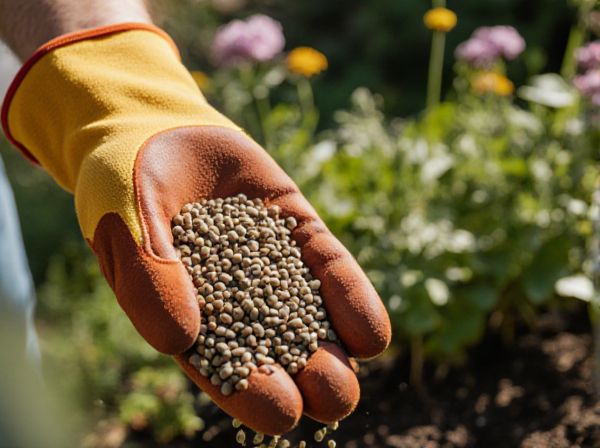
Pelleted seeds vs Raw seeds Illustration
Pelleted seeds offer enhanced handling and precise sowing, improving germination rates compared to raw seeds. Raw seeds maintain their natural coating, which may result in inconsistent planting depth and slower emergence. Choosing pelleted seeds can optimize crop uniformity and yield by ensuring consistent seed placement and protection during sowing.
Table of Comparison
| Feature | Pelleted Seeds | Raw Seeds |
|---|---|---|
| Seed Protection | Coated to protect against pests and diseases | No protective coating, vulnerable to environmental stress |
| Planting Precision | Uniform size and shape for accurate sowing | Irregular shape and size, affecting sowing accuracy |
| Handling Ease | Easy to handle and mechanical sowing compatible | Harder to handle, less compatible with machinery |
| Germination Rate | Consistent and often improved germination | Variable germination depending on seed quality |
| Cost | Higher production cost due to processing | Lower cost, no additional processing |
| Storage Life | Extended storage life with coating preservatives | Shorter shelf life, susceptible to damage |
Introduction to Pelleted Seeds and Raw Seeds
Pelleted seeds are raw seeds coated with inert materials to improve size, shape, and handling characteristics, facilitating precise planting and better germination rates. Raw seeds remain in their natural, unprocessed state, often requiring more careful handling due to variable sizes and shapes that can affect uniform planting. The pelleting process enhances seed flowability and mechanical sowing efficiency, making it ideal for small or irregularly shaped seeds.
Understanding the Difference: Pelleted vs Raw Seeds
Pelleted seeds are coated with inert materials to enhance size, shape, and ease of planting, improving seed uniformity and reducing seed handling issues. Raw seeds, in contrast, are uncoated and retain their natural form, often requiring precise planting techniques and varying germination rates. The choice between pelleted and raw seeds depends on crop type, planting equipment compatibility, and desired seedling establishment efficiency.
Benefits of Using Pelleted Seeds in Gardening
Pelleted seeds offer precise planting with uniform size and shape, improving seed spacing and germination rates in gardening. Their coating enhances handling and protects seeds from pests and diseases while providing essential nutrients for early seedling growth. Using pelleted seeds reduces seed waste and increases overall garden productivity by ensuring better seed-to-soil contact and moisture retention.
Advantages of Planting Raw Seeds
Planting raw seeds enhances genetic diversity, enabling stronger adaptation to local environments and increasing resilience against pests and diseases. Raw seeds maintain natural coatings that improve nutrient absorption and water retention during germination, promoting healthier seedling development. This method is also cost-effective and environmentally friendly, reducing the need for chemical treatments and preserving seed viability for future planting cycles.
Germination Rates: Pelleted Seeds vs Raw Seeds
Pelleted seeds often exhibit higher germination rates compared to raw seeds due to improved seed-to-soil contact and ease of planting. The uniform shape and size of pelleted seeds facilitate precise sowing depth, promoting consistent moisture absorption and temperature conditions critical for germination. Raw seeds can suffer from irregular germination times and lower emergence percentages because of variability in seed coat hardness and size.
Sowing Techniques for Pelleted and Raw Seeds
Pelleted seeds offer precision in sowing techniques due to their uniform size and shape, allowing for consistent seed spacing and depth during planting. Raw seeds require careful handling as their irregular sizes demand adjustable sowing equipment or manual placement to ensure optimal germination. Using pelleted seeds can improve planting efficiency and seedling uniformity compared to raw seeds, particularly in mechanized or large-scale sowing operations.
Cost Comparison: Pelleted Seeds vs Raw Seeds
Pelleted seeds generally have a higher upfront cost compared to raw seeds due to the additional processes of coating and shaping, which enhance uniformity and ease of planting. Raw seeds are less expensive initially but may incur higher labor and waste costs because of inconsistent seed size and irregular sowing. When evaluating long-term expenses, pelleted seeds often provide cost savings through improved germination rates and reduced seed wastage.
Suitability for Different Crops
Pelleted seeds offer enhanced precision and uniformity, making them highly suitable for small-seeded crops like carrots, onions, and lettuce that benefit from consistent spacing and easier planting. Raw seeds are preferred for larger or hardier crops such as beans, corn, and peas where natural seed size and texture aid germination without the need for coating. Crop selection depends on seed size, planting method, and growth requirements, with pelleted seeds improving outcomes in delicate or fine-seeding crops while raw seeds maintain vigor for robust species.
Environmental Impact of Pelleted and Raw Seeds
Pelleted seeds reduce the need for chemical treatments and improve planting accuracy, minimizing resource wastage and soil disruption compared to raw seeds. Raw seeds, while often requiring less processing, can lead to uneven seeding rates and increased dependence on herbicides and pesticides, resulting in greater environmental strain. Utilizing pelleted seeds supports sustainable agriculture by enhancing seedling establishment and reducing ecological footprints associated with seed production and crop management.
Which is Better for Home Gardeners?
Pelleted seeds offer precise planting depth and spacing, enhancing germination rates and simplifying seed handling for home gardeners. Raw seeds retain their natural form and often better adaptability but require more careful planting techniques to avoid damage. For home gardens, pelleted seeds are generally better due to ease of use and consistent results, especially for beginners.
Pelleted seeds vs Raw seeds Infographic

 gardendif.com
gardendif.com